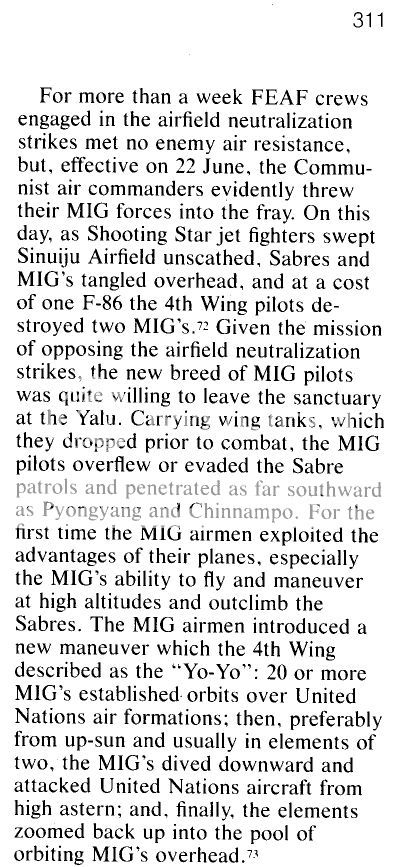主题:【原创】朝鲜上空的飞行土八路 -- 萨苏
难道 Yo-Yo 战术是火星人的?

也许是我中文不好,可没看出你说的是什么机场的电子设备哦?事后再回过头来打圆场,可不是什么好习惯。 另外呢, 我倒很想知道为什么机场被炸机场的电子设备就不能幸存? 这又是什么逻辑,我也很想知道。
说一下 就是那个把三者混为一谈的同学
在我的善意指导之下 又幡然悔悟 就去搜了东西贴了上来.
同学.
你在指责我扯淡滴时候.能不能自己先不要这么扯淡.
我是在谈到机场的时候讲的这个电子设备.
同学
你忘性是不是出奇的大了些.
怎么还"不知羞耻"滴跑来这里问呢
避免跳伞飞行员露馅。
至于截击机,是后来再细分出来的。
米国后来的战斗机基本上都是F打头的
1st LT ARTHUR EARL HUTCHINSON
就是教授提到的第二架
CAPT ARTHUR EARL HUTCHINSON
36th Fighter Bomber Squadron
8th Fighter Bomber Group
Aircraft Type: F-80C
Aircraft Number: 49-850
Air Force
Hostile, Died While Missing (MIA)
Date Of Loss: January 29, 1951
Service Number: AO2083734
NEW ORLEANS, LA
Born: July 2, 1924
Comments: Captain Hutchinson was the pilot of a F-80C Shooting Star fighter interceptor with the 36th Fighter-Bomber Squadron, 8th Fighter-Bomber Group. On January 29, 1951, while on a combat mission, his engine experienced a flame out and the aircraft crashed into the Tsushima Straits 10 miles east of Iki-Shima, Japan. His remains were not recovered.
Korean War Project Key No: 14200
http://www.koreanwar.org/html/korean_war_project_remembrance.html
http://www.36thfbs.com/fallen_fiends-2.htm
二月份,该中队战斗起飞的一架也摔在了日本,该中队可能基地就在日本.
叹一声:河里水深啊。咱这二把刀的伪军迷还是赶紧沉底儿吧。
对于YOYO机动的出处我没有找到详细的说法,应该说这个也没有一个准确的说法是谁发明的。我之前看的一些关于一战空战的传记上都有说到这个,当然毫无疑问的是这个机动方式来自于某美国飞行先驱。
关于飞行水壶P47,其实P47的翼面积大于喷火,加上强劲的动力,在水平转上其实并不吃亏。唯一的问题就在于体重,高G转向的时候要比其它飞机更容易进入尾旋,因而可以利用其马力强大的优势爬升进行Hi-YoYo攻击。但是这并不适用于所有情况,Me109具有前缘襟翼条,在失速时具有非常良好的稳定性。根据之前某飞友对德国Me109飞行员的采访上说到的,当时Me109可以在强行转向至失速的的同时进行瞬间90度转向攻击尾随的敌机侧面。这对于当时普遍经验不足而且飞机笨重的美国航空队而言还是很有威胁的。
Lo-YoYo一般被认为是Hi-YoYo的改进形式,主要还是适用于俯冲改出的攻击。因为不必做持续的过G机动(不必拉至水平即可直接进入),而且不会在机动过程中丢失目标(Hi-YoYo爬升的时候是看不见敌机的),这在米格15机动能力粗劣以及飞行员经验不足的情况是最佳的方式,这也就是为什么F86会使用螺旋爬升的方式来躲避攻击。
送花。
其实我昨天就说过了,张晓明就是直接把这架F-80算到李汉的头上。
不过呢,就像上面说的那样,这架飞机怎么会跑到日本附近坠落实在是一个无法克服的问题。
实质上这个李汉的问题,早先已经在网络上有过讨论。
http://forum.axishistory.com/viewtopic.php?f=58&t=149680
也有过认为这架F-80是战果的。 但是我个人认为最后一楼的说法比较靠谱。
Li Han's opponents January 29, 1951 were F-84's of the 27th Fighter Escort Wing.
Detailed Chinese accounts of the combat say it occurred at 1340 near Jeongju (, 定州), NK. 8 MiG's attacked an estimated 16 F-84's.
http://www.cycnet.com/army/spot/yuancha ... 221005.htm
The 5th AF Daily Summary and Statistical Summary (original record) contains only one air combat for that day, and it matches almost exactly. "At 1440I [=1340 Beijing] 12 F-84's which were providing top cover for other F-84's attacking a rail bridge at [grid coordinate] XD7297 [right near Jeongju] were attacked by 6-8 MiG type aircraft. MiG's attacked singly and in pairs, firing on all three top cover flights. Tactics included diving from 6 o'clock high, firing and climbing and turning either right or left. Short bursts were fired. MiG's broke off and headed Northwesterly direction singly and in pairs. There was no damage to friendly or enemy aircraft." The 27th FEW was the only F-84 unit in Korea at that time.
So, Li correctly identified his opponents as F-84's but as in many, many encounters in all air wars throughout history, one side recorded an aerial victory when the other side did not actually suffer a loss.
Hutchinson's loss was an unrelated accident far from the scene of that combat, and neither his nor any other F-80 unit was engaged in air combat that day.
Joe
当然了,这位大佬手头上的资料我没有办法交叉比对,也许LIGHT有办法?
本帖一共被 1 帖 引用 (帖内工具实现)
是Capt. Thomas A. Symington的飞机。
KOREAN WAR PROJECT的网上有他儿子的帖子。 可以看出他是从大邱机场起飞在汉城附近被高炮击落。
Comments: Major Symington was a decorated veteran of World War II. In Korea, he was the pilot of a F-80C Shooting Star fighter interceptor with the 36th Fighter-Bomber Squadron, 8th Fighter-Bomber Group. On February 13, 1951, after completing 3 attacks on targets east of Seoul, South Korea, his aircraft lost its wing and crashed.
From Sherry Symington: Thomas A. Symington, Jr. was the pilot of one of five F-80 aircraft on a combat support mission in the vicinity of Seoul on the afternoon of Feb. 13, 1951. Seoul was then in enemy hands. They flew out of Taegu Air Base at 1400 hours. According to the official report, while making a 4th strafing pass on an enemy target, "the left wing of Symington's plane was seen to break off, followed by the right wing, and then the tail section came off. The disintegrating aircraft immediately went into a half roll to the right and plunged to the ground in an inverted position, exploding upon impact. It is believed that the plane was struck by enemy ground fire, which was intense at the time of the crash." My mother always wondered if there was some mechanical flaw in the left wing that caused it to break off, or someone had sabotaged it. However, another person who knew these planes suggested that my dad's plane likely experienced a direct hit to the left wing strut, which made the left wing fall off and likely killed him instantly. Then the forces on the plane resulting from the one wing gone caused the right wing to fall off, and the tail section to drop off before the plane hit the ground. He is buried in the Golden Gate National Cemetery, San Bruno, California
俺就一google 党
误报战果